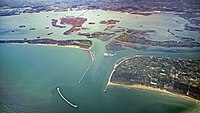
Photo from wikipedia
Abstract The consultation of various mussel farmer websites nowadays highlights a fundamental contradiction: mussels are presented as a natural food even if they are a cultivated. Farmers say that this… Click to show full abstract
Abstract The consultation of various mussel farmer websites nowadays highlights a fundamental contradiction: mussels are presented as a natural food even if they are a cultivated. Farmers say that this mollusk feeds and grows in the sea without any chemical additives as though it were in the wild. As a consequence of that, they are synonymous of “healthy food” and their “wildness” is perceived today as a quality. But this good reputation is only recent. In particular in the Venice Lagoon where in the past mussels were suspected of being indigestible and sometimes even toxic. Until the 1950s in fact, the fishermen of the island of Pellestrina, on the southern side of the Venice Lagoon, considered them inedible and called them peoci, lice (and they are still called this today). It is thanks to the fisherman Alfredo Gilebbi, from the Marche region, that mussel-farming in the lagoon was first launched in 1939: it is a new human use of mussels. This event has given rise to what can be defined as a “foundation myth” of lagoon mussel-farming. We are witness to a late discovery of mussels as a food and of the adoption, of late, of technical innovations for its exploitation. The aim of this article is to retrace the essential steps of the “rehabilitation” of this black bivalve from its ambiguous past that has become an important commercial product. For the local fishermen this has been not only a complex socio-economic phenomenon, but a transition from fishing to farming. It has also involved an evolution that brought with it a change in their local knowledge about this species.
Journal Title: Regional Studies in Marine Science
Year Published: 2017
Link to full text (if available)
Share on Social Media: Sign Up to like & get
recommendations!